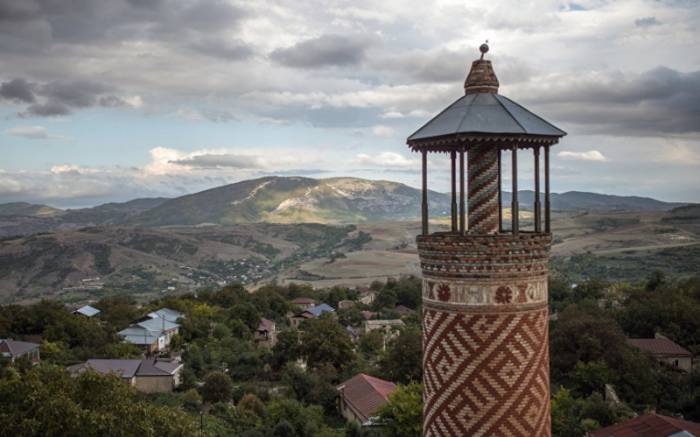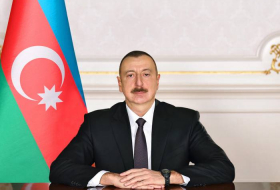Armenian-Occupied Nagorno-Karabakh is one such area, says the author.
Greenger recalled that last week, Iran Islamic Revolutionary Guard Corps (IRGC) attack boats harassed U.S. Navy, Coast Guard vessels in the Persian Gulf.
“Gen. Jack Keane comforted the audience on TV with, “do not worry, our navy has its rules of engagement all worked out if Iran steps out of line.” In one of his Coronavirus daily briefing to the nation that same week President Trump projected his sureness when he stated, “when I came into office, Iran was going to take over the entire Middle East, right now they just want to survive, … right now they do not want to mess around with us…” (Trump on Iran starting at 1:18:16-ending- at 1:23:32). I then came across thought-provoking information about IRGC-supported Iranian trucks delivering fuel to the Armenian-occupied Karabakh region of Azerbaijan,” she wrote.
The author says that the question to be asked is, why would the self-proclaimed “guardian of all the world’s Muslims” support the ongoing Armenian occupation of land that belongs to its secular northern neighbor, the Republic of Azerbaijan, whose population is primarily Shiite Muslims?
“Iran shares a 611-kilometre border with the Republic of Azerbaijan; as a result of the Nagorno-Karabakh War of 1988-94, a large part of this border stretch has been removed from Azerbaijan’s lawful control. Armenia aggressively invaded and occupied approximately 20 percent of Azerbaijan’s sovereign territory that includes the Nagorno-Karabakh region and seven surrounding districts. The outcome of the war was that over 800,000 Azerbaijani civilians were expelled from these occupied areas. And till today they are still internally displaced, scattered all over Azerbaijan. Following the occupation, Armenia created the so-called “Nagorno-Karabakh Republic,” now called “the Republic of Artsakh,” in the illegally occupied area of Azerbaijan. It is important to state that the Armenian-occupied region is internationally regarded as part of Azerbaijan while the so-called “Republic of Artsakh” is not recognized by any country, worldwide,” reads the article.
She went on to add that and so, the Armenian-controlled Iran-Azerbaijan 132 km long border portion, stretching between the Armenian town of Meghri and the Azerbaijani town of Horadiz, is where Tehran’s interfaces with the so-called “Nagorno-Karabakh Republic.”
“Built in the 13th century, the Khodaafarin Bridge, stretching across the Araz River and connecting Iran with the occupied Jabrayil district of Azerbaijan can be seen as an example of Iran’s cynicism. While Iran claims to be a nation of piety and order, at the same time it is pouring hard drugs, arms and fuel across this illegal border crossing, as well researched and penned by investigative writer Harrold Cane in his article “The Islamic Republic.”. The Khodaafarin Bridge, the main crossing point between Iran and Nagorno-Karabakh, is considered illegal under international law. Located well beyond the reach of global law and order agencies, therefore useful. For a long time Tehran, under the control of the IRGC, has been using this route for trafficking drugs, originating in Afghanistan, to their final destination, Europe,” wrote Greenger.
The author noted that the Iranian smugglers, driving trucks with Iranian license plates, openly carry narcotics into the Nagorno-Karabakh region, across the Araz River and into Europe’s back passage.
“Iran, a fervent Islamic theocracy, and Armenia, a Christian nation, make strange bedfellows. But, as it seems, money talks …According to Araz News – an independent news source focusing on ethnic Azerbaijanis, in addition to drug trafficking, the IRGC are also in charge of sending supplies, i.e. fuel, food, construction materials, etc., to the Armenia-occupied Karabakh. Most of the trucks sent to Armenia and the occupied Karabakh territory belong to the Nasr Novin Mishu Company, located in Sufian and Tabriz, Iran’s northwestern cities. The Nasr Novin Mishu Company is one of the subsidiaries of Nasr Company, a company operating under the auspices of IRGC in the northwestern part of Iran,” the author wrote.
Greenger noted that according to my sources, Iranian trucks, coming from the north-western part of Iran, enter the Karabakh region using at least two different routes and satellite images show the two crossing points. “One widely held route is from Tabriz to Meghri, a southern Armenian border town with Iran-to Nagorno-Karabakh’s capital, Stepanakert (Khankendi), via the Goris-Lachin highway.”
The second route is from Khomarly’s north-east, in the Iran’s Ardabil province, leading to the Jabrayil district of Azerbaijan, which is crossing a portion of the Iran-Azerbaijan border that has been controlled by Armenia since the early 1990s, she added.
“These crossing points, on the Iranian side, are connected to Iran’s M12 Highway. The recent footage, which I watched when reading Rufat Ahmedzade article, shows trucks and cars with Iranian license plates transporting fuel and food to the occupied Azerbaijani territories. Baku reacted fiercely to the footage and demanded from Iran an official investigation. Iran has adamantly refuted the claims. The video brings to focus Iran’s long-ongoing involvement in supplying the Karabakh’s illegal Armenian-run regime with vital resources,” reads the article.
The author notes that sadly, Tehran conducts a two-faced policy towards Baku. “For one, it claims to support the territorial integrity of Azerbaijan, yet it allows Iranian trucks and cars to enter the region, tacitly supporting the UN-condemned Armenian occupation of Azerbaijan’s lands.”
As for the sanctions, Greenger recalled that President Trump pulled the US out of The Joint Comprehensive Plan of Action (JCPOA), commonly known as the Iran Nuclear Deal and has imposed heavy sanctions on Iran.
“With mounting pressure, well felt by the Iranian regime, Iranian officials are seeking alternative routes to circumvent the sanctions. The Islamic Republic has long used banks in Armenia and the occupied Karabakh region to avoid US and international sanctions. In August 2019, the US Department of Commerce imposed sanctions on Armenian and Georgian companies linked to and trading with blacklisted Iranian companies. Armenia’s foreign policy is aligned with Moscow and Tehran. Its dependency on Iran poses a major threat to West’s interests in the South Caucasus and the Caspian region,” reads the article.
The author believes that in its relations with Azerbaijan and Armenia, Tehran’s geopolitics is twofold: the official policy, and the pragmatic one, based on its national interests.
“With a large Azerbaijani population to its northern border, Tehran fears that a strong Baku may become an active advocate for Iranian-Azerbaijanis’ rights within Iran. The Islamic Republic knows well that its suppression of ethnic minorities’ rights has created distrust between its ethnic minorities and Tehran. Iranian-Azerbaijani population – some 30 million, residing mainly in Iran’s northwestern provinces – is the largest non-Persian ethnic group in Iran. After the collapse of the Soviet Union and the formation of the staunchly secular Republic of Azerbaijan that is bordering northern Iran, it is possible that Iran fears a potential “Azerbaijani irredentism” inside its territory,” says Greenger.
The author believes that Armenian control over Azerbaijani lands, bordering Iran’s north-western region, appears to be beneficial for Tehran.
“It creates a ‘buffer zone’ between Azerbaijan and Iran’s north-western Azerbaijani populated regions. Any Armenia-Azerbaijan conflict resolution, in favour of Azerbaijan, may not be in the interest of Iran either. The present status-quo in the Armenian-occupied Azerbaijan regions bordering Iran ‘solves’ a national security problem for Tehran. Since its 2nd declaration of independence, in the early 1990s, Azerbaijan has chosen to be strategically aligned with the West, including the US and Israel, which Iran considers to be its archenemies. The fear of Azerbaijani irredentism inside Iran, the secular nature of the government in Baku and its close partnership with the West have facilitated the emergence of a strong alliance between Iran and Armenia. The adage “the enemy of my enemy is my friend” well characterizes the Iran-Armenia nexus. Iran has even gone as far as supporting radical Shia and separatist groups in Azerbaijan,” reads the article.
She went on to add that so far Azerbaijan has been somewhat balancing its open strategic partnership with the US and Israel while having normal neighborly relations with Iran to the extent, to date, even not opening a diplomatic envoy in Israel, despite being Israel’s closest majority-Muslim ally.
“Considering Iran’s increased belligerence, I suggest Baku should soon open an embassy in Israel and take further actions to intensify the mutually beneficial Israeli-Azerbaijani military-intelligence partnership and cooperation. Iran’s current activities remind me of the idiom, ‘when the cat’s away, the mice will play.’ The world is busy defending itself from the Coronavirus pandemic, which seems to be an opportunity for bad actors to benefit from. Without supervision, they will do as they please, especially in disregarding or breaking rules. Iran-Armenia nexus is the case in point,” concludes the author.
More about: Nagorno-Karabakh Iran Armenia
















































